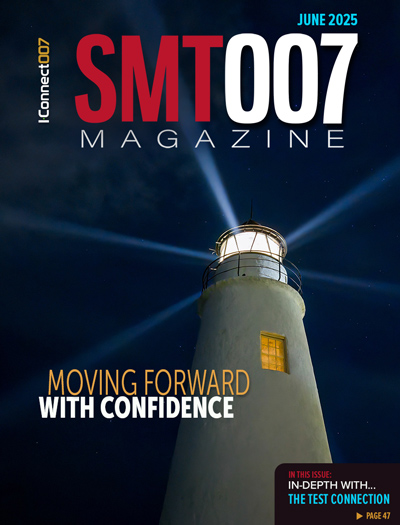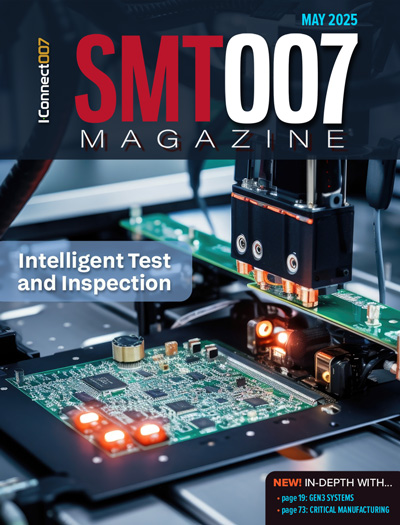-

-
News
News Highlights
- Books
Featured Books
- smt007 Magazine
Latest Issues
Current Issue
What's Your Sweet Spot?
Are you in a niche that’s growing or shrinking? Is it time to reassess and refocus? We spotlight companies thriving by redefining or reinforcing their niche. What are their insights?

Moving Forward With Confidence
In this issue, we focus on sales and quoting, workforce training, new IPC leadership in the U.S. and Canada, the effects of tariffs, CFX standards, and much more—all designed to provide perspective as you move through the cloud bank of today's shifting economic market.

Intelligent Test and Inspection
Are you ready to explore the cutting-edge advancements shaping the electronics manufacturing industry? The May 2025 issue of SMT007 Magazine is packed with insights, innovations, and expert perspectives that you won’t want to miss.
- Articles
- Columns
- Links
- Media kit
||| MENU - smt007 Magazine
IDC: Semiconductor Foundry 2.0 Market is Entering the Growth Phase from Recovery with 11% YoY Growth in 2025
March 24, 2025 | IDCEstimated reading time: 2 minutes
According to IDC ’s Worldwide Semiconductor Supply Chain Tracking Intelligence latest report, the global semiconductor market, following a recovery in 2024, is expected to experience steady growth in 2025. The broadly defined Foundry 2.0 market— encompassing foundry, non-memory IDM, OSAT, and photomask making—is projected to reach a market size of $298 billion in 2025, with year-over-year growth of 11%, signaling a transition from a recovery phase in 2024 to a growth phase in 2025. Over the long term, the compound annual growth rate (CAGR) from 2024 to 2029 is projected to reach 10%. This growth is catalyzed by the continuous rise in AI demand and a gradual recovery in non-AI demand.
The foundry sector remains the core driver of semiconductor manufacturing. Industry leader TSMC (Taiwan Semiconductor Manufacturing Company) leverages its technological edge in advanced nodes below 5nm and advanced packaging CoWoS, securing robust orders for AI accelerator manufacturing. With utilization consistently at full load, TSMC is expected to expand its market share in the Foundry 2.0 market to 37% in 2025.
While other foundry manufacturers face pressure from price erosion in mature nodes, the rebound in demand for consumer electronics—such as smartphones, PCs, notebooks, TVs, and wearables—has driven a projected 4% average increase in utilization for mature nodes. This resurgence fuels a significant expansion of the overall foundry market, expected to grow by 18% in 2025.
Non-Memory IDM Faces Challenges
The non-memory IDM (Integrated Device Manufacturer) sector, hampered by insufficient deployment in AI accelerators, will experience limited expansion in 2025. Intel is aggressively promoting its process technologies, particularly the 18A process alongside Intel 3/Intel 4 processes, which are anticipated to maintain its market share in the Foundry 2.0 market at approximately 6%.
Meanwhile, IDM specializing in automotive and industrial sectors—such as Infineon, Texas Instruments, STMicroelectronics, and NXP—have completed inventory adjustments. However, market demand is expected to remain weak in the first half of 2025, with stabilization projected for the second half. Collectively, these factors limit the overall non-memory IDM sector to a modest growth of 2% in 2025.
OSAT Welcomes AI-Driven Growth
The Outsourced Semiconductor Assembly and Test (OSAT) sector is benefiting from IDMs increasing outsourcing to foundry due to advanced nodes demands, shifting packaging and testing needs to OSAT vendors. While traditional packaging and testing businesses remain lukewarm, the strong demand for AI accelerators has spurred a rise in advanced packaging orders. Vendors such as SPIL (under ASE), Amkor, and KYEC are actively taking on more CoWoS-related orders, collectively driving the overall OSAT industry to an expected growth of 8% in 2025.
“The semiconductor manufacturing chain is entering a new wave of expansion. AI continues to drive demand for advanced nodes and advanced packaging, while traditional application markets gradually recover, presenting the industry with diversified development opportunities,” said Galen Zeng, senior research manager at IDC Asia/Pacific. “However, the industry must navigate multiple variables, including geopolitical risks, national policies (such as China’s consumption stimulus measures, U.S. factory construction subsidies, and potential U.S. chip tariffs), supply-demand fluctuations from new capacity, and the commercialization progress of AI applications. These factors will shape the long-term development trajectory of the semiconductor industry."
Suggested Items
Electronics Manufacturing & Assembly Collaborative (EMAC) Announces Innovative Student Competition
07/15/2025 | EMACThe Electronics Manufacturing & Assembly Collaborative (EMAC) recently announced the launch of the Bright Manufacturing Challenge 2025, a revolutionary hands-on competition that transforms how students experience electronics manufacturing and robotics engineering.
I-Connect007 Editor’s Choice: Five Must-Reads for the Week
07/11/2025 | Andy Shaughnessy, Design007 MagazineThis week, we have quite a variety of news items and articles for you. News continues to stream out of Washington, D.C., with tariffs rearing their controversial head again. Because these tariffs are targeted at overseas copper manufacturers, this news has a direct effect on our industry.I-Connect007 Editor’s Choice: Five Must-Reads for the Week
Infineon Advances on 300-millimeter GaN Manufacturing Roadmap as Leading Integrated Device Manufacturer (IDM)
07/10/2025 | InfineonAs the demand for gallium nitride (GaN) semiconductors continues to grow, Infineon Technologies AG is poised to capitalize on this trend and solidify its position as a leading Integrated Device Manufacturer (IDM) in the GaN market.
The Global Electronics Association Releases IPC-8911: First-Ever Conductive Yarn Standard for E-Textile Application
07/02/2025 | Global Electronics AssociationThe Global Electronics Association announces the release of IPC-8911, Requirements for Conductive Yarns for E-Textiles Applications. This first-of-its-kind global standard establishes a clear framework for classifying, designating, and qualifying conductive yarns—helping to address longstanding challenges in supply chain communication, product testing, and material selection within the growing e-textiles industry.
SMT007 Magazine July—What’s Your Competitive Sweet Spot?
07/01/2025 | I-Connect007 Editorial TeamAre you in a niche that’s growing or shrinking? Is it time to reassess and refocus? We spotlight companies thriving by redefining or reinforcing their niche—what are their insights? In the July 2025 issue of SMT007 Magazine, we spotlight companies thriving by redefining or reinforcing their niche and offer insights to help you evaluate your own.


